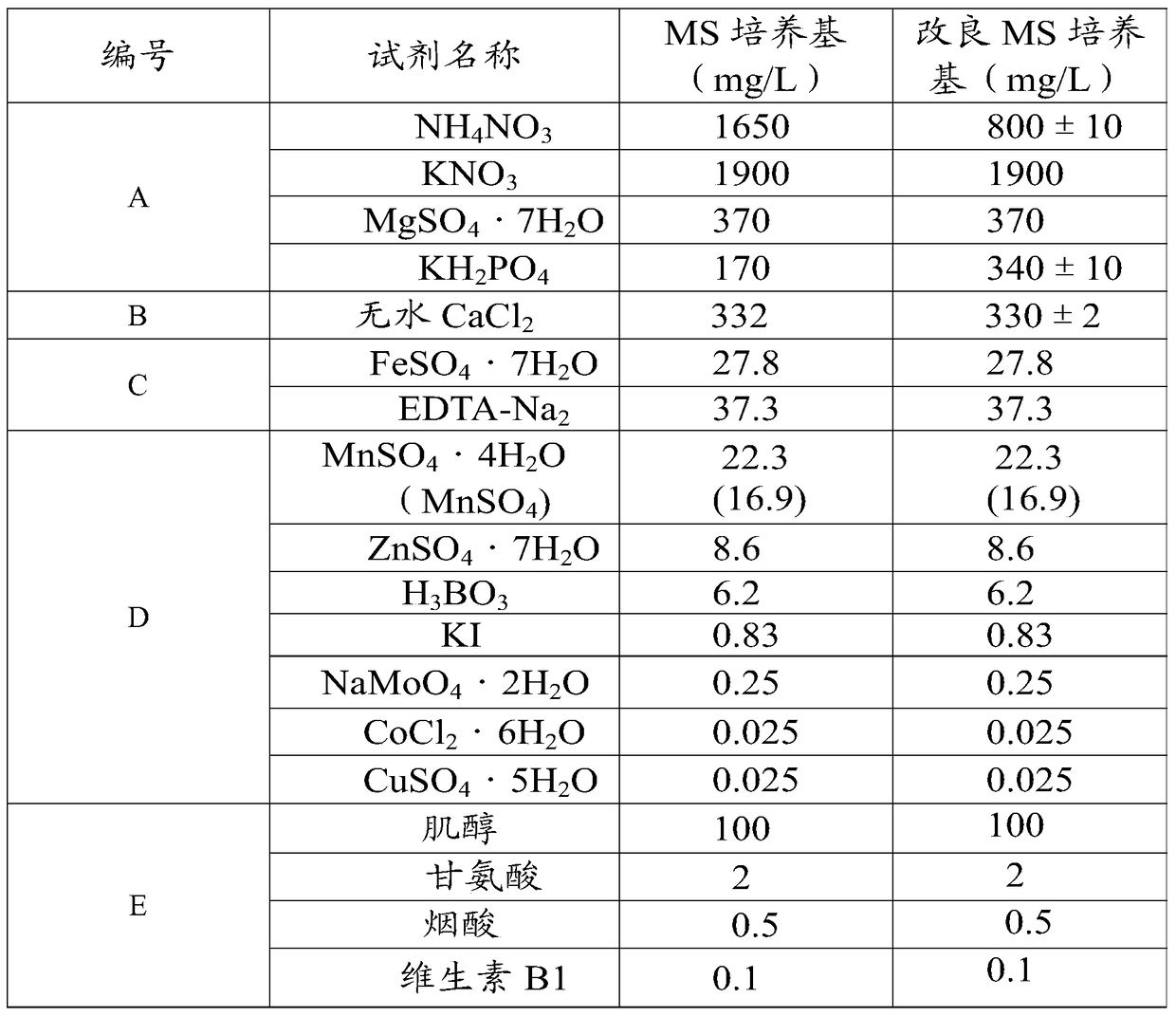A method for improving the rooting rate of tissue cultured seedlings of the leaves
A technology for planting plantlets and tissue culture seedlings, applied in the field of plant tissue culture, can solve the problems of low rooting rate and difficulty in rooting tissue culture seedlings of plantlets, so as to improve the rooting rate, reduce the probability of seedlings carrying viruses, The effect of improving the survival rate
- Summary
- Abstract
- Description
- Claims
- Application Information
AI Technical Summary
Problems solved by technology
Method used
Image
Examples
Embodiment 1
[0040] A method for improving the rooting rate of tissue cultured plantlets of the leaves, comprising the following steps:
[0041] (1) Selection and aseptic pretreatment of explants: select disease-free and robust apical buds as explants, rinse with sterile water, put the material on the ultra-clean workbench, and use 75% alcohol Soak for 30s, then treat with 0.1% mercuric chloride solution for 8 minutes, wash with sterile water 4 times, and set aside.
[0042] (2) Induction culture: cut out the 0.2mm shoot tip of the treated explants and inoculate them on the surface of the induction medium. The composition of the induction medium is: the improved MS medium contains NAA0.5mg / L, BA1.0mg / L , sucrose 30g / L, agar 5g / L, germination began after 8 days of culture, and the initial growth was slow. After 30 days of induction culture, robust sterile seedlings were obtained, and the induction rate was 95%.
[0043] (3) Cut the sterilized seedlings in step (2) into long 1.0cm budded st...
Embodiment 2
[0048] A method for improving the rooting rate of tissue cultured plantlets of the leaves, comprising the following steps:
[0049] (1) Selection and aseptic pretreatment of explants: select disease-free and robust apical buds as explants, rinse with sterile water, put the material on the ultra-clean workbench, and use 75% alcohol Soak for 40s, then treat with 0.2% mercuric chloride solution for 6 minutes, wash with sterile water for 6 times, and set aside.
[0050] (2) Induction culture: cut out the 0.2mm budding stem section from the treated explants, and inoculate them on the surface of the induction medium. The composition of the induction medium is: the improved MS medium contains NAA 0.5mg / L, BA 0.5mg / L, sucrose 30g / L, agar 5g / L, germination began after 10 days of culture, and the initial growth was slow. After 30 days of induction culture, robust sterile seedlings were obtained, and the induction rate was 92%.
[0051] (3) in the step (2), the aseptic seedlings are cu...
Embodiment 3
[0056] A method for improving the rooting rate of tissue cultured plantlets of the leaves, comprising the following steps:
[0057] (1) Selection and aseptic pretreatment of explants: select disease-free and robust apical buds as explants, rinse with sterile water, put the material on the ultra-clean workbench, and use 70% alcohol Soak for 35s, then treat with 0.1% mercuric chloride solution for 14min, wash with sterile water 5 times, and set aside.
[0058] (2) Induction culture: cut out the 0.30mm shoot tip of the treated explant and inoculate it on the surface of the induction medium. The composition of the induction medium is: NAA0.4mg / L and BA0.9mg / L are contained in the improved MS medium , sucrose 32g / L, agar 5.5g / L, germination began after 8 days of culture, and the initial growth was slow. After 28 days of induction culture, robust sterile seedlings were obtained, and the induction rate was 93%.
[0059] (3) Cut the aseptic seedlings in step (2) into long 1.0cm bud s...
PUM
 Login to View More
Login to View More Abstract
Description
Claims
Application Information
 Login to View More
Login to View More - Generate Ideas
- Intellectual Property
- Life Sciences
- Materials
- Tech Scout
- Unparalleled Data Quality
- Higher Quality Content
- 60% Fewer Hallucinations
Browse by: Latest US Patents, China's latest patents, Technical Efficacy Thesaurus, Application Domain, Technology Topic, Popular Technical Reports.
© 2025 PatSnap. All rights reserved.Legal|Privacy policy|Modern Slavery Act Transparency Statement|Sitemap|About US| Contact US: help@patsnap.com


